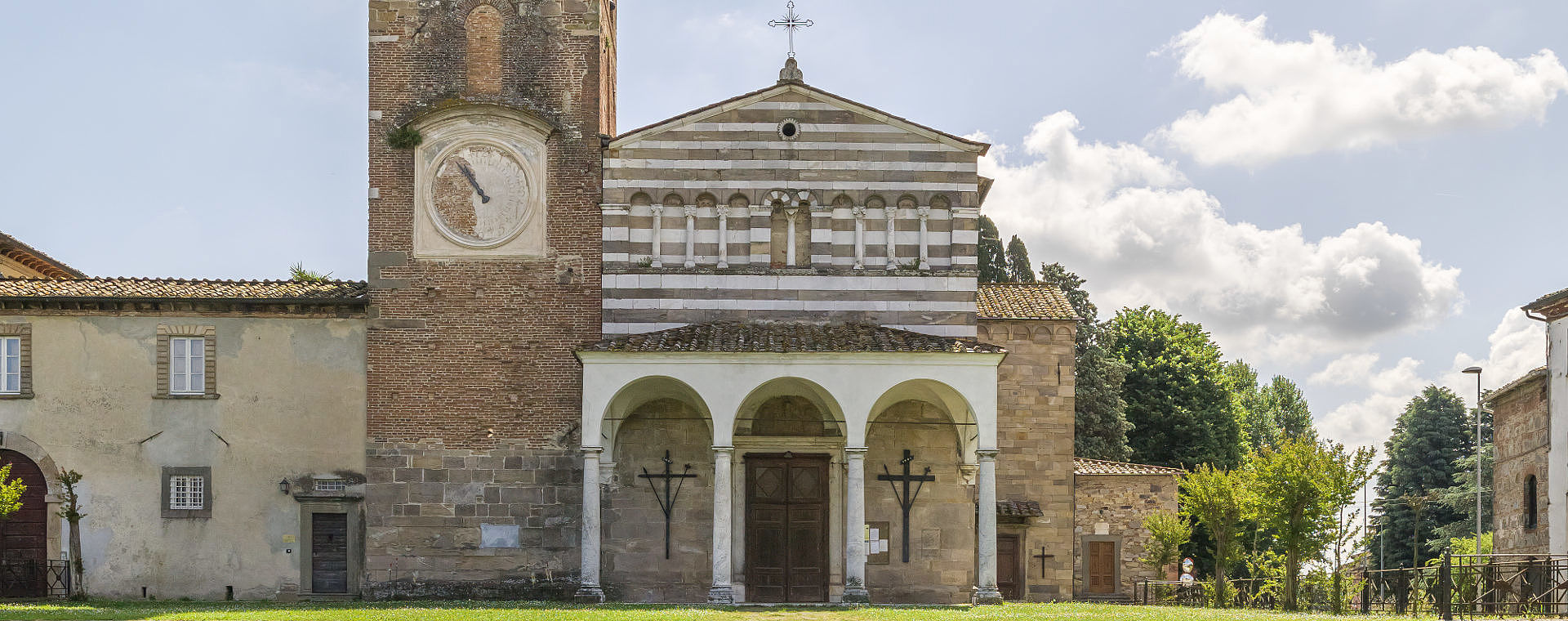Pieve di Pieve San Paolo
Denomination: Plebs S. Pauli de Gurgite
First documented: year 779.
History
The pieve dedicated to the conversion of Saint Paul has ancient origins, but it is not easy to find documents about the real date of construction. The first document that refers to this church is a parchment of 747, but it is only in the 779 that it is mentioned as parish church: S. Pauli de Gurgite plebs battesimali. In a document of 988, the church appears to be dedicated to Saint John the Baptist, according to the spreading Middle Ages tradition of adding the name of the Baptist.
It is presumed that the original building was destroyed by the Goths in 405, during the barbarian invasions, and then rebuilt by Saint Frediano between 561 and 589, as happened to other churches.
The church, the bell tower and the parsonage were built in an elevated position, in order to avoid the floods of the Serchio river (or Auser, its ancient name), whose bed bifurcated in that area.
The first preromanic building from the Middle Ages is completely lost. In the first half of the 13th century, the church was partially restored: the façade, the sides of the nave (characterized by the rows in romanic style) and the bell tower were renewed.
The third and definitive enlargement, between 1600 and 1650, involved the apse: two lateral branches, that form the present transept and give the church its cross shape, were added, along with the chancel and the typical frontal porch. In the nave we can still find the door posts, the architraves and the lunettes of the ancient medieval doors, now closed. The sides are surmounted by monolitical archs, sustained by decorated shelves.
Architecture
The church that we can now admire is the result of a series of restorations.
The façade of the building (1816), turned towards west, has a porch with four marble columns, shelves and chapiters. The entire façade is characterized by a chromatic game in which stripes of white marble and grey stone are alternated.
In the middle of the façade there is a little loggia of great artistic value, in which architecture and sculptoreus decoration are brilliantly mixed together. The loggia is formed by a series of lancet archs delineated by "parastre". In the middle of them we can find a mullioned window. The original mullioned window, that had a stained glass window, was bricked up in 1795 so that an organ could be set against the wall. The chapiters of the marble columns are ornated with human and animal figures that reminds the Biduino culture. In the lunettes of the inferior archs there are stone bas-relieves on great interest.
The bell tower is 28 metres high and is dated 1246. It is located on the right side of the church. The inferior part is made of a kind of stone of the Monti Pisani, while the superior part is made of bricks and is ornated by big windows. The summit is characterized by a guelfic crenellation sustained by lancet archs. The crenellation is an evidence of the ancient military usage of the tower. The area, in fact, was the scenary of battles between soldiers of Lucca, Pisa and Florence. In 1914, a part of the crenellation fell on the parish church and damaged the roof, probably after being hit by lightning. Since then, a lightning rod was installed on the bell tower.
After the restoration of the roof, the interior was vastly modified according to the eighteen-century style. In 1798, over the main altar, an arch with chalk figures was built after an uplift of the ceiling. The cornice that run around the parish was built in this same period, and columns and pilasters were covered with marble.
Between 1865 and 1903, outside the church, a garden with two fields linked by a marble staircase was created.
Works of art
We have to mention the five altars originally made of wood an then replaced with marble ones.
- the Main Altar (1733) is located in front of the chancel and is made of white and yellow marble from Carrara.
- the Altar dedicated to Saint John the evangelist (1734) is located on the right side of the Major Altar and is made of Carrara marble. The oil on wood of Agostino Marti (important artist of Lucca between 1488 and 1543) has a great value and represents Saint John writing the Gospel sorrounded by angels.
- the Altar dedicated to Saint John the apostle (1760) is located o nthe left side of the Major Altar and is made of Carrara marble. Another works of Marti decorates the altar and represents Saint Andrew reading a book sorrounded by angels.
- Altar dedicated to the Most Holy Crucifix (1602) is located on the right aisle and it is surmounted by a painting (1816) that represents the Crucifix, Maria Maddalena and Saint John.
- the Altar dedicated to the Virgin and Sain Joseph (1702, and originally dedicated to Saint Sebastian and Saint Anthony abbot) is located in the left aisle.
One of the altars is also dedicated to the Immaculate Conception and represents the Virgin. It is to notice that the dogma of the Immaculate Conception was ratified in 1854 and that, therefore, this worship was already established in the pieve.
Thanks to donations, since the first half of the 14th century, the parish has been enriched with paintings, oils and frescoes. Along with the works of Marti, we have to mention the Crucifixion of Mone from Pisa, alias Giovanni del Sordo (over the altar in the right aisle), and the stunning Marriage of the Virgin of P.Filippo Mannucci. This painting is flanked by the Madonna del Rosario of Ippolito Sani (1560-1625). The two paintings were collocated one next to the other in order to reach the same measure of the Crucifixion the counterpart hangs over the marble alter replaced in 1702.
